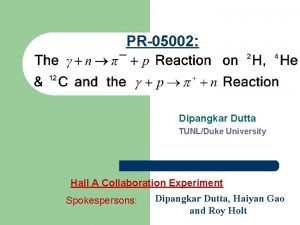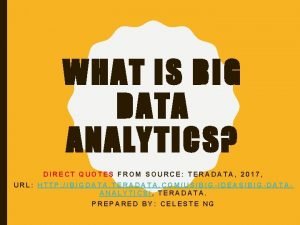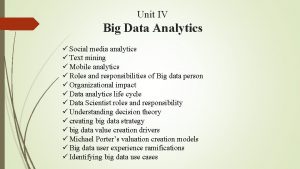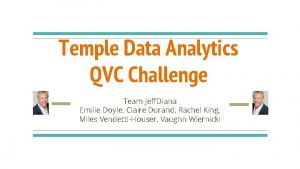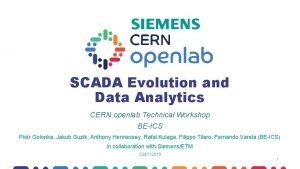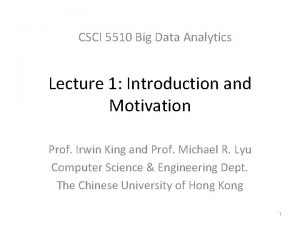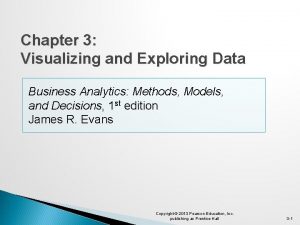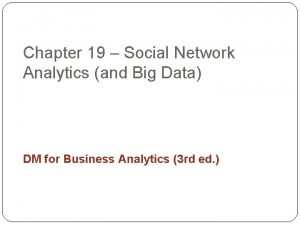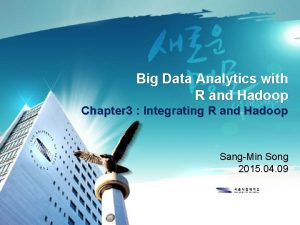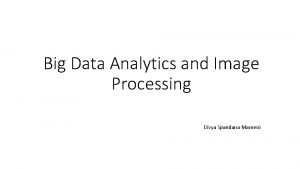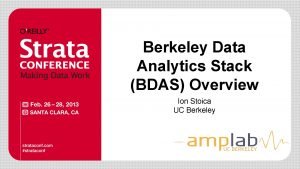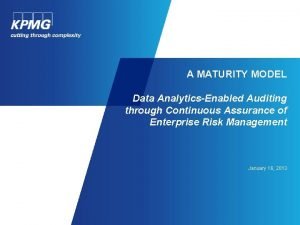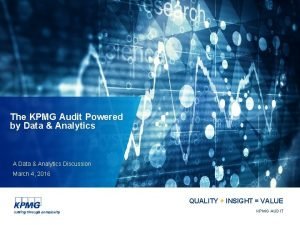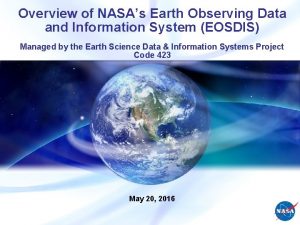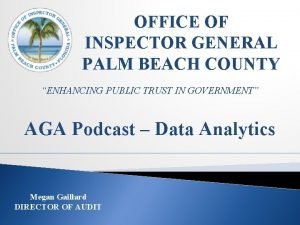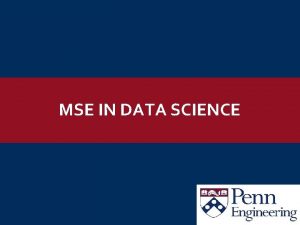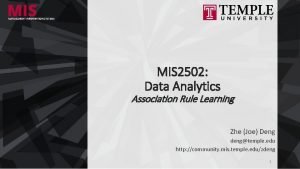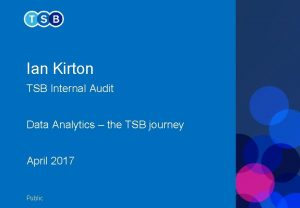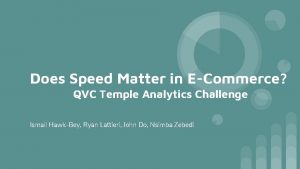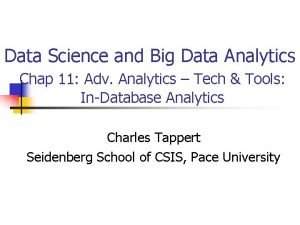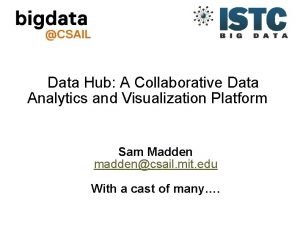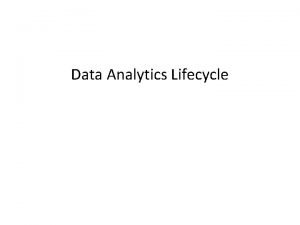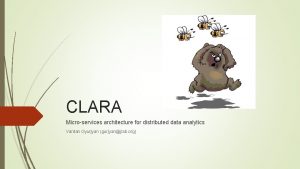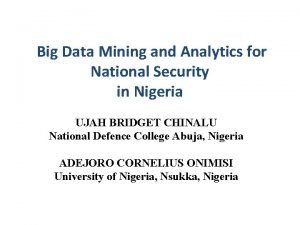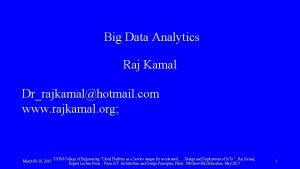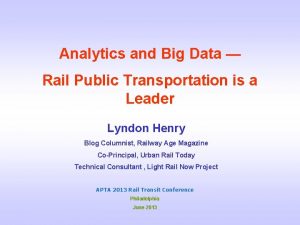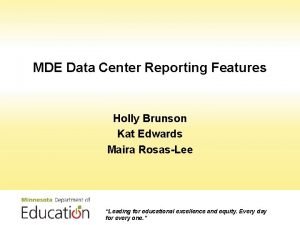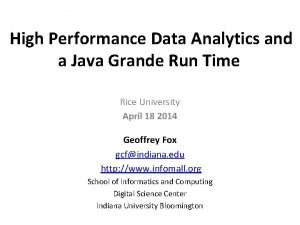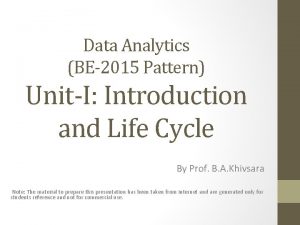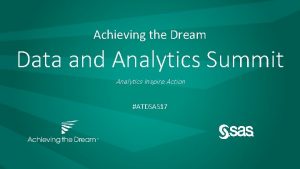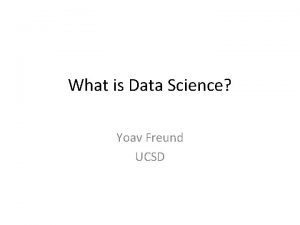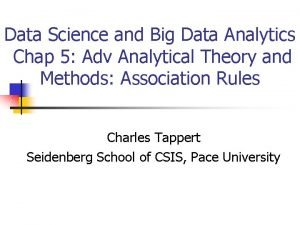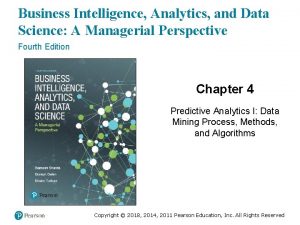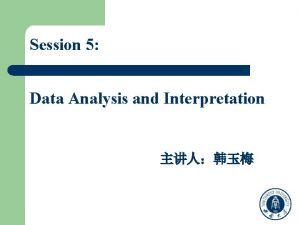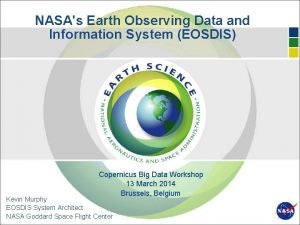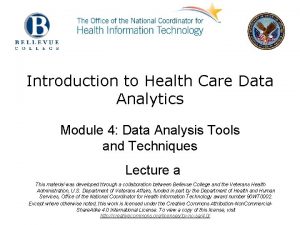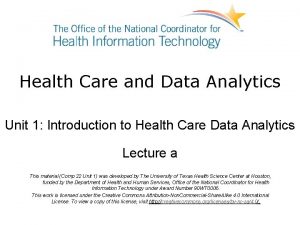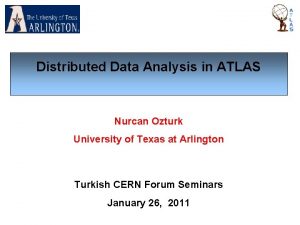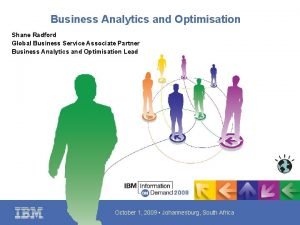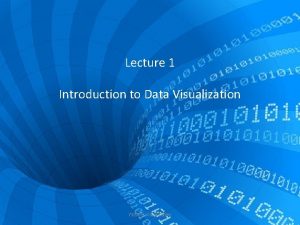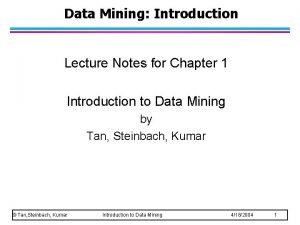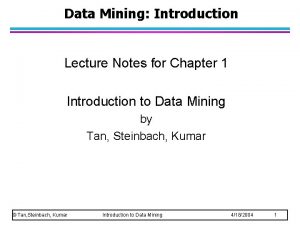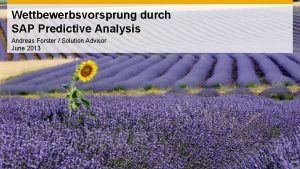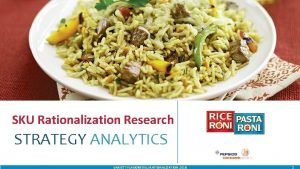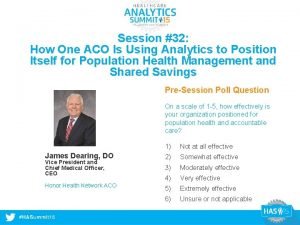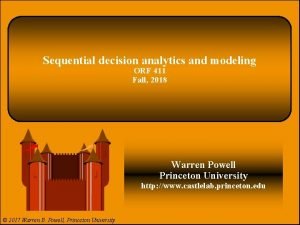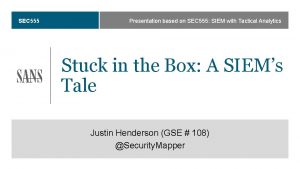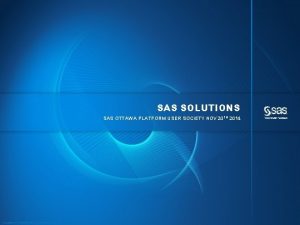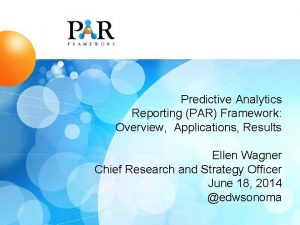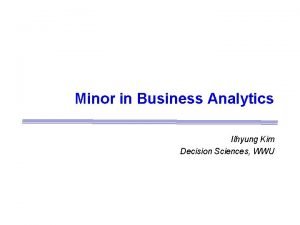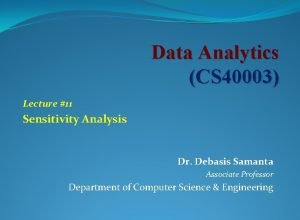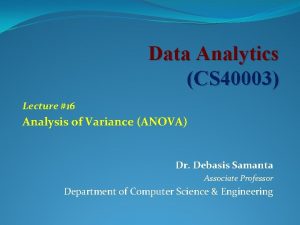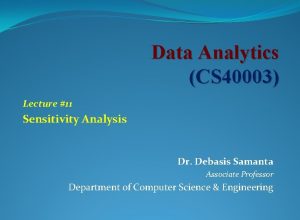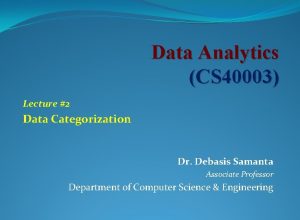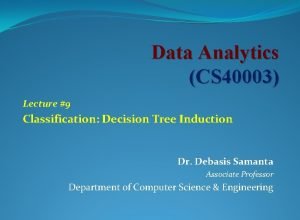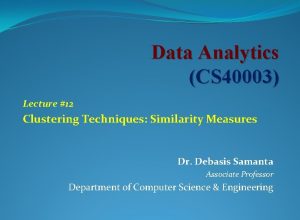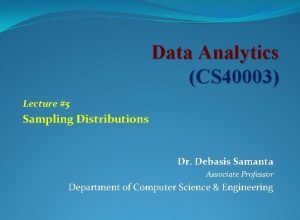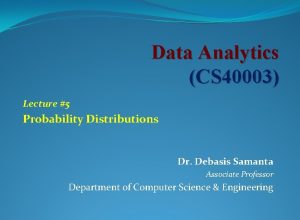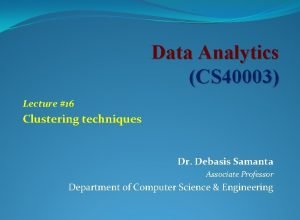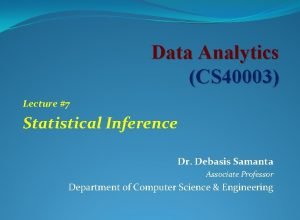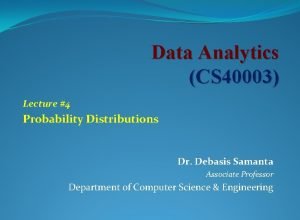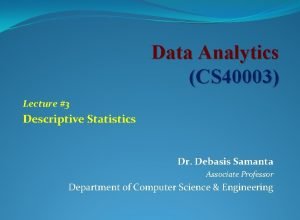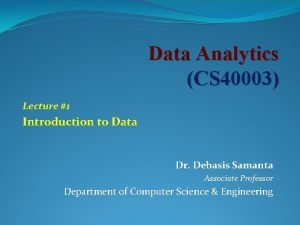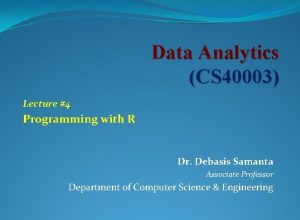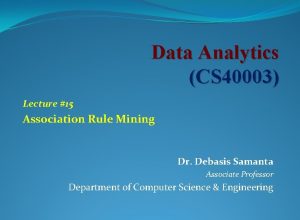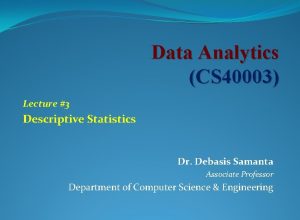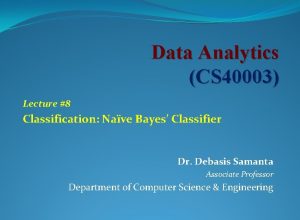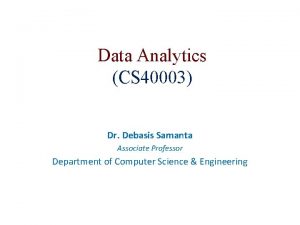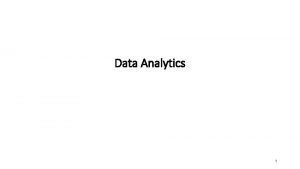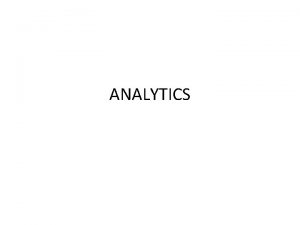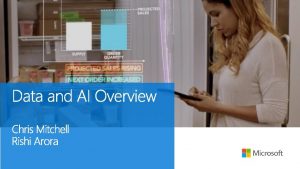Data Analytics CS 40003 Lecture 7 Relation Analysis
























































































- Slides: 88

Data Analytics (CS 40003) Lecture #7 Relation Analysis Dr. Debasis Samanta Associate Professor Department of Computer Science & Engineering

Quote of the day. . Nothing great was ever achieved without enthusiasm. � RALPH WALDO EMERSON, American philosopher CS 40003: Data Analytics 2

This presentation includes… � CS 40003: Data Analytics 3

Hypothesis Testing Strategies � There are two types of tests of hypotheses üParametric tests (also called standard test of hypotheses). q Non-parametric tests (also called distribution-free test of hypotheses) CS 40003: Data Analytics 4

Parametric Tests : Applications � Usually assume certain properties of the population from which we draw samples. • Observation come from a normal population • Sample size is small • Population parameters like mean, variance, etc. are hold good. • Requires measurement equivalent to interval scaled data. CS 40003: Data Analytics 5

Hypothesis Testing : Non-Parametric Test �Non-Parametric tests o Does not under any assumption o Assumes only nominal or ordinal data Note: Non-parametric tests need entire population (or very large sample size) CS 40003: Data Analytics 6

Relationship Analysis �Example: Wage Data A large data regarding the wages for a group of employees from the eastern region of India is given. In particular, we wish to understand the following relationships: § Employee’s age and wage: How wages vary with ages? § Calendar year and wage: How wages vary with time? § Employee’s age and education: Whether wages are anyway related with employees’ education levels? CS 40003: Data Analytics 7

Relationship Analysis � Example: Wage Data § Case I. Wage versus Age § From the data set, we have a graphical representations, which is as follows: ? § How wages vary with ages? CS 40003: Data Analytics How wages vary with ages? 8

Relationship Analysis � Example: Wage Data § Employee’s age and wage: How wages vary with ages? Interpretation: On the average, wage increases with age until about 60 years of age, at which point it begins to decline. CS 40003: Data Analytics 9

Relationship Analysis � Example: Wage Data § Case II. Wage versus Year § From the data set, we have a graphical representations, which is as follows: ? How wages vary with time? CS 40003: Data Analytics 10

Relationship Analysis � Example: Wage Data § Wage and calendar year: How wages vary with years? Interpretation: There is a slow but steady increase in the average wage between 2010 and 2016. . CS 40003: Data Analytics 11

Relationship Analysis � Example: Wage Data § Case III. Wage versus Education § From the data set, we have a graphical representations, which is as follows: ? Whether wages are related with education? CS 40003: Data Analytics 12

Relationship Analysis � Example: Wage Data § Wage and education level: Whether wages vary with employees’ education levels? Interpretation: On the average, wage increases with the level of education. CS 40003: Data Analytics 13

Relationship Analysis Given an employee’s wage can we predict his age? Whether wage has any association with both year and education level? etc…. CS 40003: Data Analytics 14

An Open Challenge! � CS 40003: Data Analytics 15

Yahoo! Just decide the values of a and b (as if storing one point’s data only!) Note: Here, tricks was to find a relationship among all the points. CS 40003: Data Analytics 16

Measures of Relationship � Univariate population: The population consisting of only one variable. Here, statistical measures are suffice to find a relationship. � Bivariate population: Here, the data happen to be on two variables. CS 40003: Data Analytics 17

Measures of Relationship � Multivariate population: If the data happen to be one more than two variable. ? If we add another variable say viscosity in addition to Pressure, Volume or Temperature? CS 40003: Data Analytics 18

Measures of Relationship In case of bivariate and multivariate populations, usually, we have to answer two types of questions: Q 1: Does there exist correlation (i. e. , association) between two (or more) variables? If yes, of what degree? Q 2: Is there any cause and effect relationship between the two variables (in case of bivariate population) or one variable in one side and two or more variables on the other side (in case of multivariate population)? If yes, of what degree and in which direction? To find solutions to the above questions, two approaches are known. � Correlation Analysis � Regression Analysis CS 40003: Data Analytics 19

Correlation Analysis CS 40003: Data Analytics 20

Correlation Analysis � In statistics, the word correlation is used to denote some form of association between two variables. � Example: Weight is correlated with height Example: The correlation may be positive, negative or zero. � Positive correlation: If the value of the attribute A increases with the increase in the value of the attribute B and vice-versa. � Negative correlation: If the value of the attribute A decreases with the increase in the value of the attribute B and vice-versa. � Zero correlation: When the values of attribute A varies at random with B and vice-versa. CS 40003: Data Analytics 21

Correlation Analysis � In order to measure the degree of correlation between two attributes. CS 40003: Data Analytics 22

Correlation Analysis � Do you find any correlation between X and Y as shown in the table? . Note: In data analytics, correlation analysis make sense only when relationship make sense. There should be a cause-effect relationship. CS 40003: Data Analytics 23

Correlation Analysis CS 40003: Data Analytics 24

Correlation Coefficient � CS 40003: Data Analytics 25

Correlation Coefficient CS 40003: Data Analytics 26

Correlation Coefficient CS 40003: Data Analytics 27

Correlation Coefficient CS 40003: Data Analytics 28

Measuring Correlation Coefficients � There are three methods known to measure the correlation coefficients � Karl Pearson’s coefficient of correlation � This method is applicable to find correlation coefficient between two numerical attributes � Charles Spearman’s coefficient of correlation � This method is applicable to find correlation coefficient between two ordinal attributes � Chi-square coefficient of correlation � This method is applicable to find correlation coefficient between two categorical attributes CS 40003: Data Analytics 29

Pearson’s Correlation Coefficient CS 40003: Data Analytics 30

Karl Pearson’s Correlation Coefficient � This is also called Pearson’s Product Moment Correlation Definition 7. 1: Karl Pearson’s correlation coefficient CS 40003: Data Analytics 31

Karl Pearson’s coefficient of Correlation Example 7. 1: Correlation of Gestational Age and Birth Weight � A small study is conducted involving 17 infants to investigate the association between gestational age at birth, measured in weeks, and birth weight, measured in grams. CS 40003: Data Analytics 32

Karl Pearson’s coefficient of Correlation Example 7. 1: Correlation of Gestational Age and Birth Weight � We wish to estimate the association between gestational age and infant birth weight. � In this example, birth weight is the dependent variable and gestational age is the independent variable. Thus Y = birth weight and X = gestational age. � The data are displayed in a scatter diagram in the figure below. CS 40003: Data Analytics 33

Karl Pearson’s coefficient of Correlation Example 7. 1: Correlation of Gestational Age and Birth Weight � For the given data, it can be shown the following Conclusion: The sample’s correlation coefficient indicates a strong positive correlation between Gestational Age and Birth Weight. CS 40003: Data Analytics 34

Karl Pearson’s coefficient of Correlation � CS 40003: Data Analytics 35

Rank Correlation Coefficient CS 40003: Data Analytics 36

Charles Spearman’s Correlation Coefficient � CS 40003: Data Analytics 37

Charles Spearman’s Correlation Coefficient Definition 7. 2: Charles Spearman’s correlation coefficient � The Spearman’s coefficient is often used as a statistical methods to aid either providing or disproving a hypothesis. CS 40003: Data Analytics 38

Charles Spearman’s Coefficient of Correlation Example 7. 2: The hypothesis that the depth of a river does not progressively increase with the width of the river. A sample of size 10 is collected to test the hypothesis, using Spearman’s correlation coefficient. CS 40003: Data Analytics 39

Charles Spearman’s Coefficient of Correlation Step 1: Assign rank to each data. It is customary to assign rank 1 to the largest data, and 2 to next largest and so on. Note: If there are two or more samples with the same value, the mean rank should be used. CS 40003: Data Analytics 40

Charles Spearman’s Coefficient of Correlation Step 2: The contingency table will look like CS 40003: Data Analytics 41

Charles Spearman’s Coefficient of Correlation Spearaman’s rank correlation coefficient � CS 40003: Data Analytics 42

Charles Spearman’s Coefficient of Correlation � CS 40003: Data Analytics 43

χ2 -Correlation Analysis CS 40003: Data Analytics 44

Chi-Squared Test of Correlation � CS 40003: Data Analytics 45

Contingency Table Given a data set, it is customary to draw a contingency table, whose structure is given below. CS 40003: Data Analytics 46

Entry into Contingency Table: Observed Frequency In contingency table, an entry Oij denotes the event that attribute A takes on value ai and attribute B takes on value bj (i. e. , A = ai, B = bj). CS 40003: Data Analytics 47

Entry into Contingency Table: Expected Frequency In contingency table, an entry eij denotes the expected frequency, which can be calculated as CS 40003: Data Analytics 48

Definition 7. 3: χ2 -Value CS 40003: Data Analytics 49

2 value are those whose � The cell that contribute the most to the �� actual count is very different from the expected. 2 statistics tests the hypothesis that A and B are independent. � The �� The test is based on a significance level, with (n-1) ×(m-1) degrees of freedom. , with a contingency table of size n×m � If the hypothesis can be rejected, then we say that A and B are statistically related or associated. CS 40003: Data Analytics 50

Example 7. 3: Survey on Gender versus Hobby. � Suppose, a survey was conducted among a population of size 1500. In this survey, gender of each person and their hobby as either “book” or “computer” was noted. The survey result obtained in a table like the following. � We have to find if there is any association between Gender and Hobby of a people, that is, we are to test whether “gender” and “hobby” are correlated. CS 40003: Data Analytics 51

Example 7. 3: Survey on Gender versus Hobby. � From the survey table, the observed frequency are counted and entered into the contingency table, which is shown below. GENDER HOBBY Male Female Total Book Computer Total CS 40003: Data Analytics 52

Example 7. 3: Survey on Gender versus Hobby. � From the survey table, the expected frequency are counted and entered into the contingency table, which is shown below. GENDER HOBBY Male Female Total Book Computer Total CS 40003: Data Analytics 53

� CS 40003: Data Analytics 54

� FATALITY HANDEDNESS Left-Handed Right-Handed Total Non-Fatal Total CS 40003: Data Analytics 55

Regression Analysis CS 40003: Data Analytics 56

Regression Analysis � The regression analysis is a statistical method to deal with the formulation of mathematical model depicting relationship amongst variables, which can be used for the purpose of prediction of the values of dependent variable, given the values of independent variables. � Classification of Regression Analysis Models � Linear regression models 1. Simple linear regression 2. Multiple linear regression � Non-linear regression models CS 40003: Data Analytics 57

Simple Linear Regression Model � CS 40003: Data Analytics 58

Regression Analysis � CS 40003: Data Analytics 59

True versus Fitted Regression Line � CS 40003: Data Analytics 60

� CS 40003: Data Analytics 61

Least Square method � CS 40003: Data Analytics 62

� CS 40003: Data Analytics 63

� CS 40003: Data Analytics 64

CS 40003: Data Analytics 65

Multiple Linear Regression � CS 40003: Data Analytics 66

Multiple Linear Regression � CS 40003: Data Analytics 67

Multiple Linear Regression � CS 40003: Data Analytics 68

Non Linear Regression Model � CS 40003: Data Analytics 69

Solving for Polynomial Regression Model � CS 40003: Data Analytics 70

Auto-Regression Analysis CS 40003: Data Analytics 71

Auto Regression Analysis � Regression analysis for time-ordered data is known as Auto-Regression Analysis � Time series data are data collected on the same observational unit at multiple time periods Example: Indian rate of price inflation CS 40003: Data Analytics 72

Auto Regression Analysis � Examples: Which of the following is a time-series data? � Aggregate consumption and GDP for a country (for example, 20 years of quarterly observations = 80 observations) � Yen/$, pound/$ and Euro/$ exchange rates (daily data for 1 year = 365 observations) � Cigarette consumption per capita in a state, by years � Rainfall data over a year � Sales of tea from a tea shop in a season CS 40003: Data Analytics 73

Auto Regression Analysis � Examples: Which of the following graph is due to time-series data? CS 40003: Data Analytics 74

Use of Time Series Data � To develop forecast model � What will the rate of inflation be next year? � To estimate dynamic causal effects � If the rate of interest increases the interest rate now, what will be the effect on the rates of inflation and unemployment in 3 months? in 12 months? � What is the effect over time on electronics good consumption of a hike in the excise duty? � Time dependent analysis � Rates of inflation and unemployment in the country can be observed only over time! CS 40003: Data Analytics 75

Modeling with Time Series Data � Correlation over time � Serial correlation, also called autocorrelation � Calculating standard error � To estimate dynamic causal effects � Under which dynamic effects can be estimated? � How to estimate? � Forecasting model build on regression model CS 40003: Data Analytics 76

Auto-Regression Model for Forecasting � Can we predict the tend at a time say 2017? CS 40003: Data Analytics 77

Some Notations and Concepts � Yt = Value of Y in a period t � Data set [Y 1, Y 2, … YT-1, YT]: T observations on the time series random variable Y � Assumptions � We consider only consecutive, evenly spaced observations � For example, monthly, 2000 -2015, no missing months � A time series Yt is stationary if its probability distribution does not change over time, that is, if the joint distribution of (Yi+1, Yi+2, …, Yi+T) does not depend on i. � Stationary property implies that history is relevant. In other words, Stationary requires the future to be like the past (in a probabilistic sense). � Auto Regression analysis assumes that Yt is stationary. CS 40003: Data Analytics 78

Some Notations and Concepts � CS 40003: Data Analytics 79

Some Notations and Concepts � Autocorrelation � The correlation of a series with its own lagged values is called autocorrelation (also called serial correlation) Definition 7. 4: j-th Autocorrelation CS 40003: Data Analytics 80

Some Notations and Concepts � For the given data, say ρ1 = 0. 84 � This implies that the Dollars per Pound is highly serially correlated � Similarly, we can determine ρ2 , ρ3 …. etc. , and hence different regression analyses CS 40003: Data Analytics 81

Auto-Regression Model for Forecatsing � A natural starting point forecasting model is to use past values of Y, that is, Yt-1, Yt-2, … to predict Yt � An autoregression is a regression model in which Yt is regressed against its own lagged values. � The number of lags used as regressors is called the order of autoregression � In first order autoregression (denoted as AR(1)), Yt is regressed against Yt-1 � In p-th order autoregression (denoted as AR(p)), Yt is regressed against, Yt-1, Yt-2, …, Yt-p CS 40003: Data Analytics 82

p-th Order Auto. Regression Model Definition 7. 5: p-th Auto. Regression Model � CS 40003: Data Analytics 83

Computing AR Coefficients � A number of techniques known for computing the AR coefficients � The most common method is called Least Squares Method (LSM) � The LSM is based upon the Yule-Walker equations � Here, ri (i = 1, 2 , 3, …, p-1) denotes the i-th auto correlation coefficient. � β 0 can be chosen empirically, usually taken as zero. CS 40003: Data Analytics 84

Reference �The detail material related to this lecture can be found in The Elements of Statistical Learning, Data Mining, Inference, and Prediction (2 nd Edn. ), Trevor Hastie, Robert Tibshirani, Jerome Friedman, Springer, 2014. CS 40003: Data Analytics 85

Any question? You may post your question(s) at the “Discussion Forum” maintained in the course Web page! CS 40003: Data Analytics 86

Questions of the day… 1. For a given sample data the correlation coefficient according to the Karl Pearson’s correlation analysis is found to be r = 0. 79 with degree of freedom 69. Further, with significant test , the t-value is calculated as t = 2. 36. From the t-test table, it is found that with degree of freedom 69, the t-value at 5% confidence level is 3. 61. What is the inference that you can have in this case? 2. For a given degree of freedom, if α, the value of confidence level increases, then t-value increases. Is the statement correct? If not, what is the correct statement? Justify your answer. You can refer the following figure in your explanation. CS 40003: Data Analytics 87

Questions of the day… � CS 40003: Data Analytics 88
 Teramond
Teramond 01:640:244 lecture notes - lecture 15: plat, idah, farad
01:640:244 lecture notes - lecture 15: plat, idah, farad Exploratory data analysis lecture notes
Exploratory data analysis lecture notes Predictive analytics quotes
Predictive analytics quotes Big data and social media analytics
Big data and social media analytics Temple data analytics challenge
Temple data analytics challenge Scada big data analytics
Scada big data analytics Data science lifecycle
Data science lifecycle Data analytics meaning
Data analytics meaning Visualizing and exploring data in business analytics
Visualizing and exploring data in business analytics Network analytics big data
Network analytics big data Scale out architecture in big data analytics
Scale out architecture in big data analytics Rhipe architecture
Rhipe architecture Big data image processing
Big data image processing Berkeley data analytics stack
Berkeley data analytics stack Apa itu enterprise risk management
Apa itu enterprise risk management External data
External data Siemens data analytics
Siemens data analytics Earth observing systems data analytics
Earth observing systems data analytics Audit data analytics
Audit data analytics Mse data science upenn
Mse data science upenn Data analytics association
Data analytics association Watson analytics for social media
Watson analytics for social media Tropim
Tropim Data analytics capability framework
Data analytics capability framework Temple data analytics challenge
Temple data analytics challenge Big data analytics is usually associated with
Big data analytics is usually associated with Data analytics framework deloitte
Data analytics framework deloitte Collaborative data analytics with datahub
Collaborative data analytics with datahub Data conditioning refers to
Data conditioning refers to Microservices data analytics
Microservices data analytics Big data analytics for national security
Big data analytics for national security Big data analytics raj kamal ppt
Big data analytics raj kamal ppt Big data rail
Big data rail Ait data analytics
Ait data analytics Mobile analytics big data
Mobile analytics big data High performance data analytics hpda
High performance data analytics hpda Mde data center
Mde data center High performance data analytics definition
High performance data analytics definition Current analytical architecture
Current analytical architecture Atd data and analytics summit
Atd data and analytics summit Yoav freund
Yoav freund Poultry data analytics
Poultry data analytics Graph analytics for big data
Graph analytics for big data Big data analytics life cycle
Big data analytics life cycle Business intelligence analytics and data science
Business intelligence analytics and data science Wake tech data analytics
Wake tech data analytics Data analytics definition
Data analytics definition Second major in data analytics
Second major in data analytics Earth observing systems data analytics
Earth observing systems data analytics Introduction to healthcare data analytics
Introduction to healthcare data analytics Unit 1 health care systems
Unit 1 health care systems Nurcan atlas
Nurcan atlas Data analytics architecture
Data analytics architecture Shane radford
Shane radford Sensitivity analysis lecture notes
Sensitivity analysis lecture notes Factor analysis lecture notes
Factor analysis lecture notes Analysis of algorithms lecture notes
Analysis of algorithms lecture notes Streak plate
Streak plate Power system analysis lecture notes
Power system analysis lecture notes Bayesian classification in data mining lecture notes
Bayesian classification in data mining lecture notes Data mining lecture notes
Data mining lecture notes Data visualization lecture
Data visualization lecture Data mining lecture notes
Data mining lecture notes Data mining lecture notes
Data mining lecture notes Content analysis is a type of secondary data analysis
Content analysis is a type of secondary data analysis Data collection procedures
Data collection procedures Data preparation and basic data analysis
Data preparation and basic data analysis Data acquisition and data analysis
Data acquisition and data analysis Sap predictive analytics demo
Sap predictive analytics demo Web analytics wikipedia
Web analytics wikipedia Hotel industry foundations & introduction to analytics
Hotel industry foundations & introduction to analytics Higher education web analytics
Higher education web analytics Proxy google analytics
Proxy google analytics Sla servicing student loans
Sla servicing student loans Sku rationalization methodology
Sku rationalization methodology Aco analytics
Aco analytics Sequential decision analytics and modeling
Sequential decision analytics and modeling Sec555: siem with tactical analytics
Sec555: siem with tactical analytics Sas bookrunner commodity capture
Sas bookrunner commodity capture Sap business one analytic
Sap business one analytic Power bi for qualitative data
Power bi for qualitative data Sql server ml services
Sql server ml services Predictive analytics reporting framework
Predictive analytics reporting framework Pentaho business analytics integrations
Pentaho business analytics integrations Advanced analytics oracle
Advanced analytics oracle Web analytics process
Web analytics process Mmi analytics
Mmi analytics Wwu business analytics minor
Wwu business analytics minor
